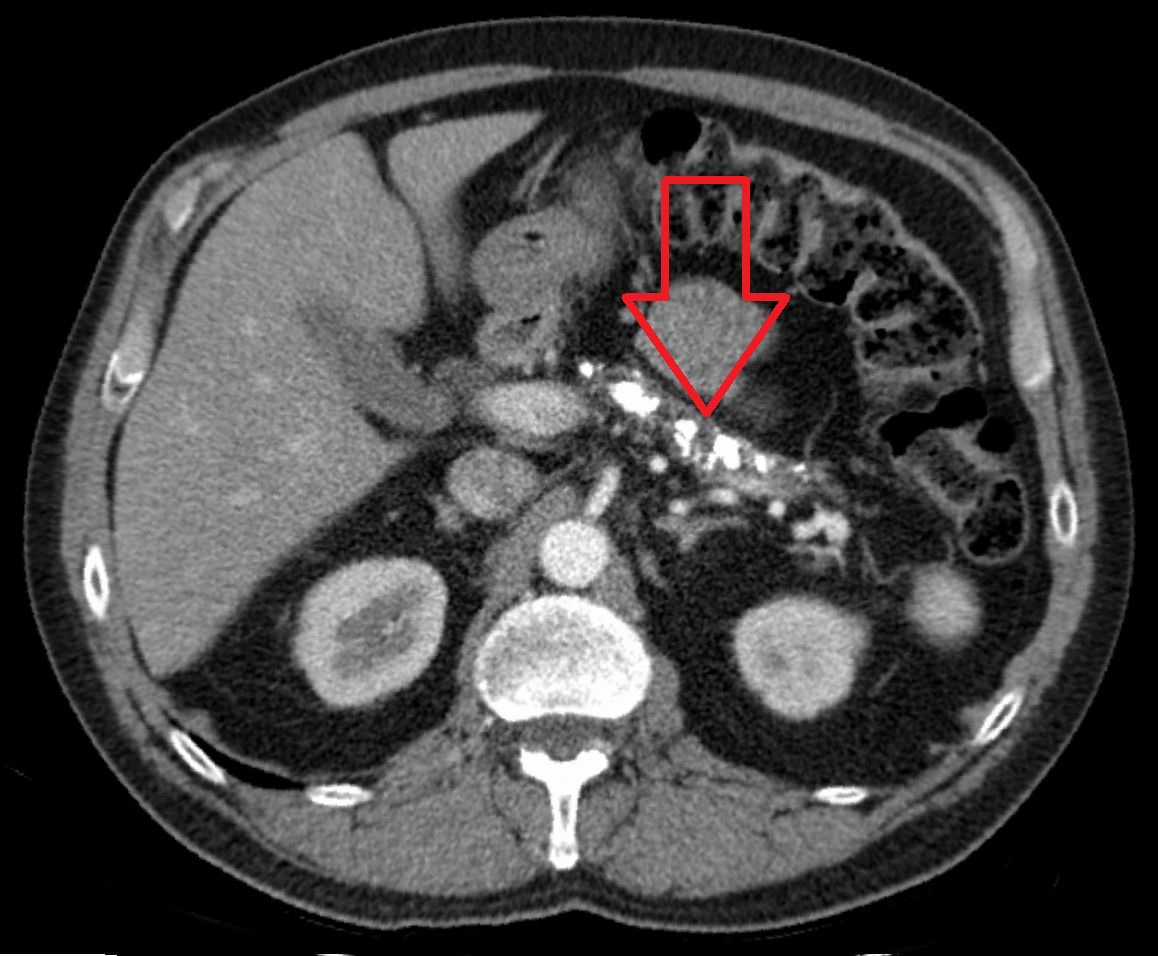Pancreas-
-Acute/Chronic Pancreatitis-
-characterized by inflammation of the pancreas. Can be acute or chronic
-causes auto digestion of pancreatic and peri-pancreatic tissues from the continuing release of digestive enzymes and vasoconstrictive substances
-most common etiologies gallbladder disease and alcohol (85-90%) of cases
-other etiologies include trauma, viral infections (mumps, cocksackie), hypercalcemia, hypertriglyceridemia, DKA, azathioprine, estrogen, thiazides, valproate, tetracycline, scorpion stings, methanol ingestion, SLE, periarteritis nodosa, and idiopathic
-signs and symptoms: abdominal pain, nausea, vomiting, low grade fever, tachycardia, abdominal distention, and crackle in the bases
-Cullen's Sign-echymotic discoloration in the periumbilical region with severe pancreatitis
-Grey Turner's Sign-ecyhmotic discoloration in the flank with severe pancreatitis
-Labs reveal elevated lipase (more sensitive) and amylase (60-80% sensitive)
-Amylase and lipase considered specific if three times normal value
-May have mildly elevated WBC's, hypocalcemia, mild increase in bilirubin, decreased albumin, increased BUN, decreased HCO3
-Radiographs may find pancreatic calcifications in chronic disease, localized ileus, left pleural effusion/atelectasis
-Treatment is IV hydration, NPO, anti emetics, and analgesics
-Need to rest the pancreas
-Complications include: necrotizing pancreatitis, pancreatic pseudocyst, pancreatic abscess, exocrine insufficiency, and diabetes from endocrine insufficiency
-Ranson Criteria-
-Initial Criteria
Age >55
WBC > 16,000
Glucose >200
LDH > 350
AST > 250
-Criteria after 48 hours
Decrease in Hct >10%
Increase in BUN > 5
Calcium < 8.0
PaO2 < 60
BE > 4
Fluid Sequestration > 6 Liters
-Number of Criteria Present=
0-2=1% mortality
3-4=16% mortality
5-6=40% mortality
>7=100% mortality
-Chronic Pancreatitis presents as chronic unrelenting pain with flares over many years.
-Chronic Pancreatitis "burns out" over time and endocrine and exocrine dysfunction can develop
-Recommended cessation of alcohol intake, small meals, good hydration, and cessation of smoking
-Pancreatic enzyme supplements suppress exocrine secretion and relieve some pain in some patients
-Patients may need pseudocyst drainage if symptomatic
-Neoplasms-
-Pancreatic cancer is the forth in the cancers causing death in the US
-Pancreatic Ductal Adenocarcinoma- makes up about 85 percent of pancreatic cancers
-Diagnosis requires biopsy or surgical resection. Has high mortality rate
-usually spreads to adjacent structures such as the duodenum, portal vein, and mesenteric vessels
-Pancreatic Intraepithelial Neoplasia (PanIN) is a small intraductal non invasive lesion that is formed by metaplasia and increased proliferation of the epithelium
-most pancreatic adenocarcinomas arise from PanIN
-considered to by a precursor to invasive ductal adenocarcinoma
-Intraductal Papillary Mucinous Neoplasms (IPMN) are cystic neoplasms derived from the pancreatic ducts
-Patients with IPMN can present with current episodes of pancreatitis
-Diagnosis is suspected when the papilla of Vater has thick mucus extruding from it
-Malignant potential is determined by the histology rather than its location
-Mucinous Cystic Neoplasms (MCN) are sharply demarcated cystic masses with a thick fibrous wall that occur in the body or tail of the pancreas
-Serous Cystadenomas are benign neoplasms
-Solid Pseudopapillary Neoplasms- begin as solid neoplasm that become cystic as they grow large and the cells become so far removed their blood supply and undergo apoptosis or necrosis
-Most of the time these lesions are cleared by resection but metastasis has been reported in a small percentage
-Acinar Cell Carcinoma-rare malignant neoplasms that are solid but sometimes cystic. Prognosis is better than ductal adenocarcinomas
-Pancreatoblastomas-malignant lesions presumed to be of stem cell origin. There is less of mortality rate for these lesions than with ductal adenocarcinomas

In February 2017, my immune system was not functioning correctly and my primary care physician did a N.A.E.T. Treatment with Laser Acupuncture and Auricular Acupuncture to try to desensitize my body from the different allergies and allergies to the metals. This procedure began to make me drained and very fatigued. He recommended that I have a GI Stool test done as I was having GI issues in February 2017, to check for parasites, pathogens, bacterial flora, and fungi/yeasts. The results showed that I had a Bacterial Pathogen called Salmonella, high amounts of normal bacterial flora, called Enterococcus spp. and Escherichia spp., 2 parasites called Dientamoeba fragilis and Endolimax nana, and 2 types of fungi/yeasts called Candida spp. and Geotrichum spp. The doctor recommended that I take Dr Itua Herbal Medicine to get rid of the Candida as that was the main concern at the time and I did purchase Dr Itua Herbal Medicine and after taking it all as instructed I was totally cured so is a urged form of heart to believe in herbal medicines but yes indeed natural remedies should be recognize around the globe because is the only healing that has no side effect on each every healing, I will recommend anyone here with health challenge to contact Dr Itua Herbal Center on E-Mail drituaherbalcenter@gmail.com / Www.drituaherbalcenter.com he capable of all kind of disease like Cancer,Hiv,Herpes,Kidney disease,Parkinson,ALS,Copd. with a complete cure without coming back.
ReplyDelete